*We are a reader-supported website. When you buy through links on our site, we may earn a small affiliate commission at no extra cost to you. Home Media Entertainment does not accept money for reviews.*
For one more year January was an exciting month for us as manufacturers had their chance to display their new toys for the year in the CES 2020 expo. And one major player that tends to draw a lot of attention is no other than Samsung. The Korean giant once again had a vast list of newly created devices and electronics but we will be laser focusing on their 2020 TV lineup. In our Samsung TVs for 2020 guide we will be analyzing all their new models they offer this year along with their most major specifications and features as well as all the sizes they will be released at.
With so many models and sizes it can be rather confusing to find out their differences and for that reason we also provide comprehensive tables at the end of the article with all the released models and their most major specs in order for you to be able to distinguish their key differences.
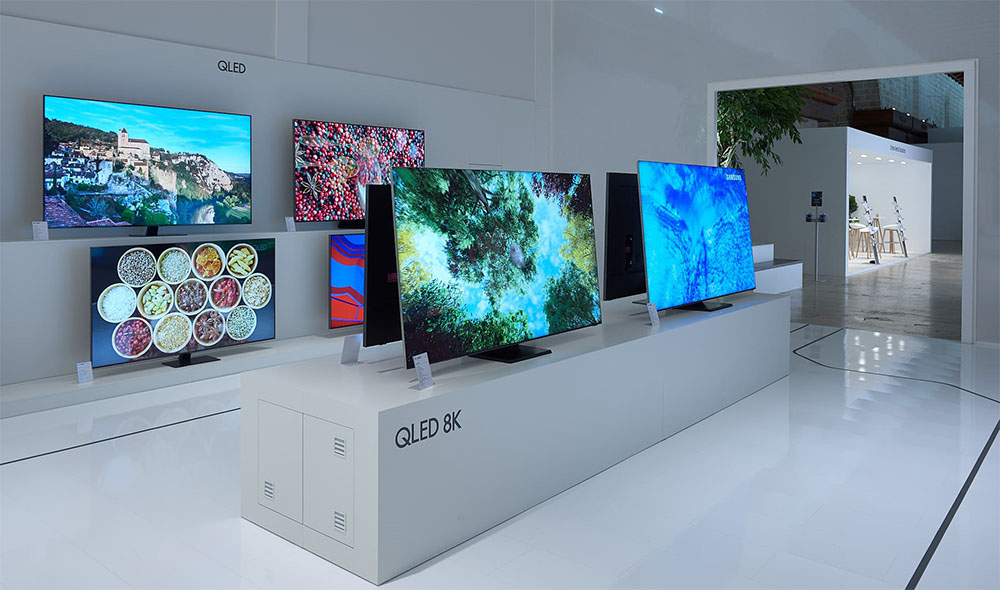
The Wall shows microLED future
So let’s take a look a little more thoroughly what Samsung has for us this year. It seems that the Korean manufacturer is still concentrating on their LED LCD technology and while their microLED tech was on display for one more year those that were hoping to finally get their hands on that will have to wait a bit longer. MicroLED was showcased by their biggest model called “The Wall”. This modular TV comes right now in various sizes from the most house friendly 75″ all the way up to the monstrous 292″ one. And while the Wall seems to be on sale it’s not the kind of model you will find in retail yet.
8K QLED TVs coming
But while microLED seems to still be a few years away from mainstream manufacturing there are signs that 8K TVs are gaining some traction as this year we find three models on offer, the Q950TS, the Q900TS and the more affordable Q800T. All of them come in various sizes from 65″ up to 85″ and use Samsung proven Quantum Dot technology.
https://youtu.be/8yuOuBiJGjk
4K QLED TVs still lead the way
But while 8K is slowly approaching Samsung still focuses mainly on their 4K QLED series that use their proprietary Quantum Dot technology. Five models are available, from the top flagships Q95T and Q90T, the middle tier Q80T and Q70T and the most cost friendly Q60T. The QLED series are being offered in a wide variety of sizes ranging from 43″ all the way up to 85″ showing how much Samsung is counting on this lineup in order to get a large piece of the market pool for one more year.
4K Crystal UHD TVs for the price conscious
And while the the 8K QLED and 4K QLED series are those getting most of the attention we should not forget their most budget friendly series which for 2020 have been named Crystal UHD series. There are four major models available with the TU8500, TU8000, TU7100 and TU7000. Now not all of these will be available to all markets while some of them have some specs variations and thus come with different model naming also. But in general the Crystal series cut many of the advanced features we find on the QLEDs in order to bring the cost down considerably for the masses.
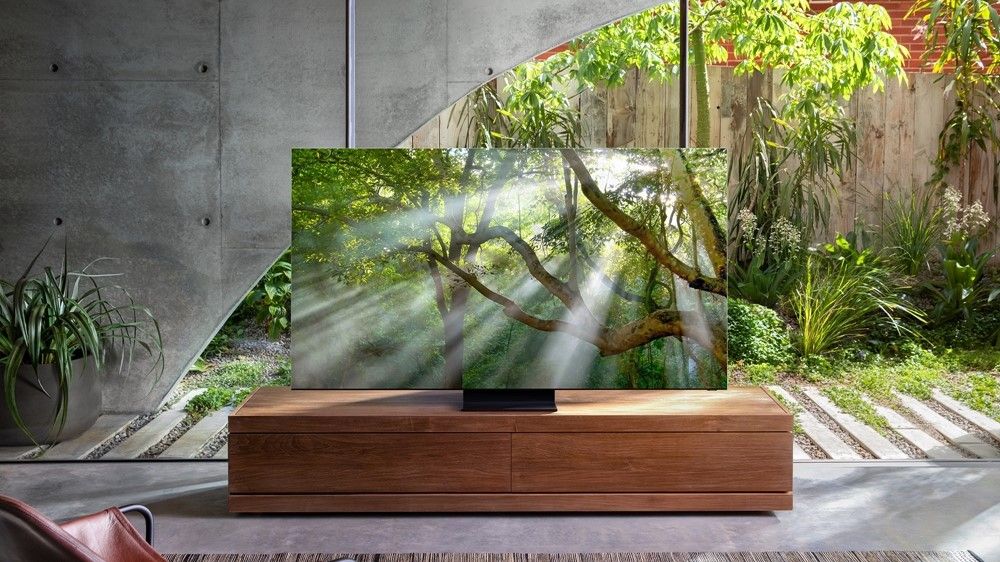
Lifestyle TVs
Lastly we should mention a special TV category that seems like it has become a standard the last few years called Lifestyle TVs. In this category we find the Frame which is a QLED model with a special design and features that makes art and display design a priority as well as the Serif which is a special QLED on a stand also featuring unique functions. Lastly Samsung seems to continue creating new ideas and for this year they showed us the Sero TV which is a rotatable TV that looks very much like an oversized smartphone.
New tech for 2020
Obviously with yearly releases new tech and features are a bit thin here and there but once in a while manufacturers tend to surprise us with their new additions. For 2020 it seems that Samsung will be using HDMI 2.1 only on their 8K and 4K QLEDs (Except the Q60T) while all the rest still remain with the older HDMI 2.0b with added features that include eARC, Auto Low Latency Mode (ALLM) and Real Game Enhancer+ which is basically Samsung’s name for ‘variable refresh rate’ technology.
But the above are tech that we had already seen in various TVs so let’s take a look at some new features that Samsung introduced for the first time in some of their 2020 models.
Dual LED
While this cannot be exactly categorized as new technology, this is the first time that Samsung will be using this variant of Edge lighting for some of their middle tier models. Dual LED actually means that Samsung is using different LED colors and by mixing them are able to produce better visual results.

Object Tracking Sound+
Samsung seems to have focused very much on improving the audio on their TVs and thus created what they call Object Tracking Sound+. This tech is using an array of speakers that are located on all four sides of the TV and is tracking the movement of objects on screen in order to project sound accordingly. This way the TV gives you the illusion of 3D audio that feels more realistic and precise.
This tech comes in two variants, with a plus on the end and without. The plus variant is using all four sides of the TV to project sound while without only uses up-firing and down-firing speakers for the same reason. The end result is obviously less accurate but also more cost friendly.
Active Voice Amplifier
With Active Voice Amplifier (AVA) the TV can distinguish if there is background noise and boost the sound accordingly in order to maintain good sound clarity. When the background noise stops the TV will automatically return to it’s previous settings without you to have to do any manual adjustments.
Q Symphony
Q Symphony seems like an intriguing feature as if it happens you to also have a Samsung soundbar the two can cooperate in order to produce better sound quality. This is achieved as both the soundbar and the TV produce sound from their respective drivers in order to create a more immersive and full soundstage. The only catch to this is that Q Symphony is compatible with only the Q-series soundbars from Samsung.
Multi View
Multi View is supposed to be an enhanced version of screen share as you can beam what you see on your smartphone directly on your TV. The difference compared to what we had till now is that with Multi View you can actually watch a TV broadcasting and also share your smartphone screen on the TV at the same time.
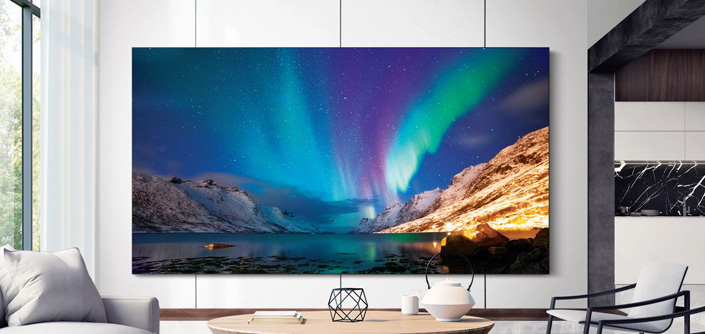
Closing
Samsung is bound to dominate the LED LCD market for one more year and they will do so by continuing to focus on their LED LCD and QLED technologies. If some were hoping for microLED to make it’s big mainstream opening seems that will have to wait a bit longer. And while the technology is there as Samsung is showing with their Wall model that is on sale it seems that is not mature enough to be used in their more mainstream series.
From what we see this year we are not going to find any major advancements at least as far as the image quality is concerned and many new features seem to focus mostly on the sound quality while there is a slow shift towards 8K also. It will be a few good years before these become lower in price to make any sense but it’s good to see that Samsung is investing on the future.
But one thing that made us a big impression and only remains to be seen how it will affect the actual quality of it’s models is the reduction of dimming zones that are used in the 4K models. All 4K TVs that come with a FALD light system feature far less zones than what we saw in their 2019 releases and Samsung decided to keep their most advanced FALD variants only for the 8K QLEDs which is a bit disappointing but also interesting to see how this will affect their performance.
Before closing this part we should mention that you can check our New Product Lineups section for more reviews and articles which we will update as we manage to get our hands on these new releases.
So without further delay let’s analyze each model separately.
8K QLED TVs
Samsung Q950TS
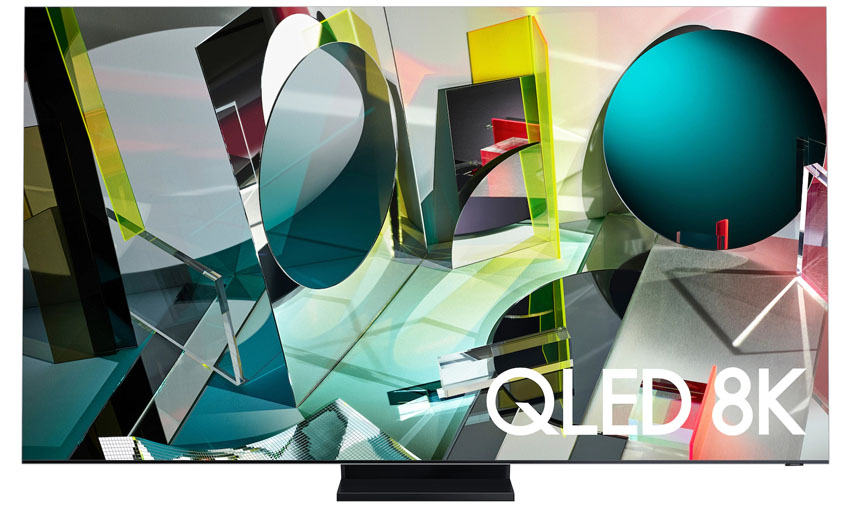
Type : Flat
When we are talking about the wide commercially available models the Q950TS is definitely the crown jewel of Samsung’s arsenal for 2020. It boasts a 8K resolution with a Quantum Dot display and comes jam packed with video and audio features to make even the most skeptical ones drool from excitement.
This unit comes with a Full Array Backlight with Local Dimming system which means better and more accurate light control while it comes with Samsung’s latest Quantum Processor 8K. Design wise things are very interesting as the Q950TS comes with an Infinity panel which means almost zero borders for an amazing level of immersion and also features the new for 2020 Object Sound Tracking+ which features drivers on all four sides of the panel for more accurate sound reproduction.
In terms of the rest of it’s extras we get AI upscaling to 8K resolution along with Adaptive picture which makes the TV to automatically adjust it’s settings depending on the environmental light, it comes with Ultra Viewing Angle technology, Real Game Enhancer+ which is Samsung’s name for Variable Refresh Rate (VRR) and obviously the full Tizen smart TV platform with all of it’s functions and features.
Lastly we should mention that the Q950TS is the only 8K Samsung TV that comes with the One Connect Box.
Specifications
- 8K resolution (7,680 x 4,320)
- QLED display technology
- Full Array Backlight with Local Dimming – Direct Full Array 32X
- Quantum HDR 32x
- HDR10+, HDR10 and HLG support
- Quantum Processor 8K
- 4.2.2CH 70W / Object Tracking Sound+, Active Voice Amplifier, Q-Symphony
- 8K AI Upscaling, Ultra Viewing Angle, Adaptive Picture, Multi-View, Real Game Enhancer+, Ambient Mode+
- 4 x HDMI / 3 x USB
- ARC / eARC
- WiFi (802.11ax), Bluetooth v4.2
- Tizen smart platform
- One Connect Box / OneRemote
Samsung Q900TS (US Only)
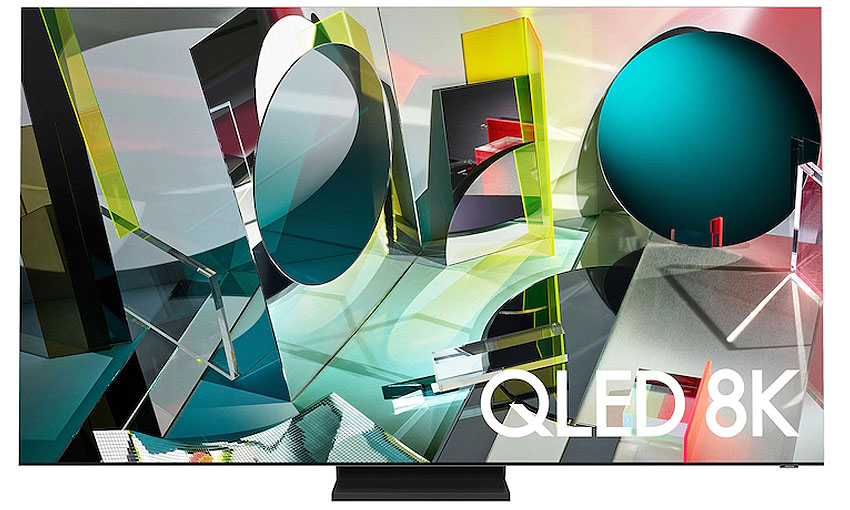
Type : Flat
Next in line in the 8K lineup comes the Q900TS which has been announced only for the US market so far and this one seems to be very similar to the Q950TS. It has the same Full Array with Local Dimming (FALD) lighting system and the same HDR capabilities (although the 65″ model seems to be less cable in it’s brightness), it also features the same Quantum Processor 8K and the same Object Tracking Sound+ audio system.
In terms of features it also comes with the full list available in it’s Tizen platform along with all the extras available. The only big difference this one seems to have is that it looses the One Connect Box and as a result all ports are located on the main body of the TV making the Q900TS also a little bit thicker than it’s bigger brother. As a result the USB ports are also reduced to two.
Specifications
- 8K resolution (7,680 x 4,320)
- QLED display technology
- Full Array Backlight with Local Dimming – Direct Full Array 32X
- Quantum HDR 32x (65″ 24X)
- HDR10+, HDR10 and HLG support
- Quantum Processor 8K
- 4.2.2CH 70W / Object Tracking Sound+, Active Voice Amplifier, Q-Symphony
- 8K AI Upscaling, Ultra Viewing Angle, Adaptive Picture, Multi-View, Real Game Enhancer+, Ambient Mode+
- 4 x HDMI / 2 x USB
- ARC / eARC
- WiFi (802.11ax), Bluetooth v4.2
- Tizen smart platform
- OneRemote
Samsung Q800T
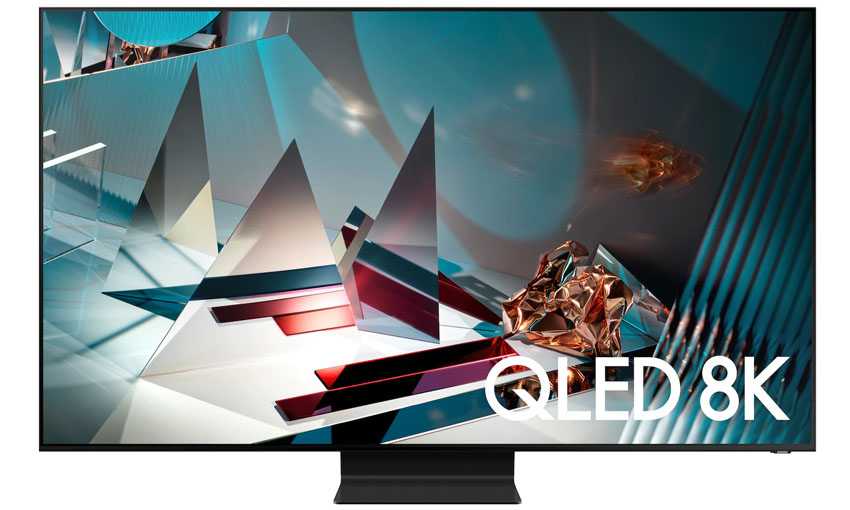
Type : Flat
The Q800T is the most affordable of all three 8K models this year and this results in some lower specs compared to the other two. First of all we once again get a Full Array with Local Dimming (FALD) light system but it comes with less dimming zones than the other 8K TVs except from the 82″ size that comes with the same number of zones as the other models. There is also a reduction on the brightness capabilities compared to the rest.
Everything else seems to be similar to the Q900TS as it features the Quantum Processor 8K with it’s AI upscaling and Adaptive Picture capabilities, it comes with the same Object Tracking Sound+ audio system and features Tizen with all the extra and smart features we can get with it.
Lastly all connections are also placed on the body of the TV so no One Connect Box here either. Basically you get an 8K TV with a less capable panel but with the same rest of features and it seems like the perfect entry 8K TV model for anyone interesting in such a purchase.
If you want to know more you can read our detailed Samsung Q800T review in the link.
Specifications
- 8K resolution (7,680 x 4,320)
- QLED display technology
- Full Array Backlight with Local Dimming – Direct Full Array 24X (82″ 32X)
- Quantum HDR 16X
- HDR10+, HDR10 and HLG support
- Quantum Processor 8K
- 4.2.2CH 70W / Object Tracking Sound+, Active Voice Amplifier, Q-Symphony
- 8K AI Upscaling, Ultra Viewing Angle, Adaptive Picture, Multi-View, Real Game Enhancer+, Ambient Mode+
- 4 x HDMI / 2 x USB
- ARC / eARC
- WiFi (802.11ac), Bluetooth v4.2
- Tizen smart platform
- OneRemote
4K QLED TVs
Samsung Q95T (UK/Europe Only)
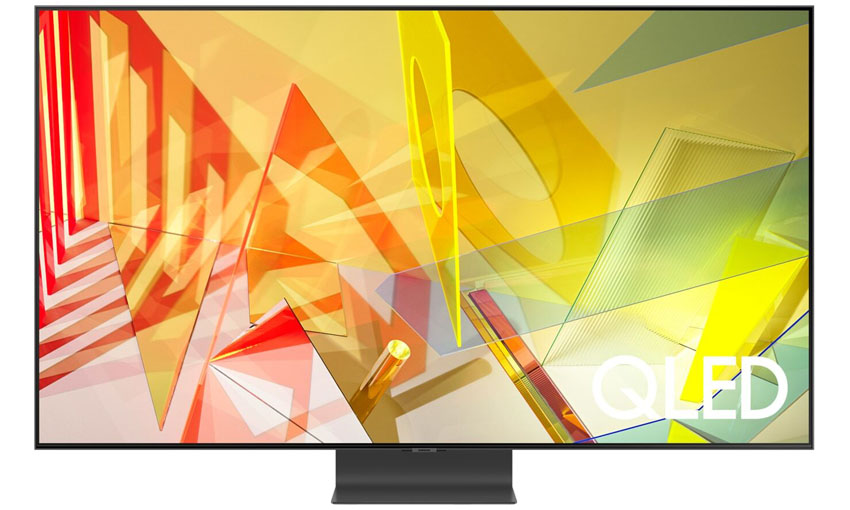
Type : Flat
With the Q95T we are moving onto the 4K territory and this is the best 4K QLED you can get in 2020. Strangely the Q95T has only been announced for European and UK markets so far and this seems like a strange move to do as the differences with the Q90T that is available on the US market are not very big.
The Q95T uses a 4K UHD Quantum Dot display along with a Full Array with Local Dimming (FALD) light system which seems to have slightly less dimming zones than the 8K TVs. Now one interesting fact is that Samsung in general has reduced the number of dimming zones in their TVs for 2020 and the top models will likely come with around 100 zones compared to last year’s Q90R 500 zones. It also comes with Quantum Processor 4K that includes all the visual and AI enhancements we get with it.
Also available is Tizen with the full range of features and services available along with One Connect Box making this the only 4K model that gets it. This model along with the rest of the 4K QLEDs (with the exception of the Q60T) also gets a single HDMI 2.1 port.
Another difference is that there is a downgrade on the audio system as the Q95T comes with a simpler version of Object Tracking Sound that features only up-firing and down-firing drivers instead of all around the panel.
Specifications
- 4K UHD resolution (3,840 x 2,160)
- QLED display technology
- Full Array Backlight with Local Dimming – Direct Full Array 16X (85″ 20X)
- Quantum HDR 16X
- HDR10+, HDR10 and HLG support
- Quantum Processor 4K
- 4.2.2CH 60W / Object Tracking Sound, Adaptive Sound+, Active Voice Amplifier, Q-Symphony
- 4K AI Upscaling, Ultra Viewing Angle, Adaptive Picture, Multi-View, Real Game Enhancer+, Ambient Mode+
- 4 x HDMI / 2 x USB
- ARC / eARC
- WiFi (802.11ac), Bluetooth v4.2
- Tizen smart platform
- One Connect Box / OneRemote
Samsung Q90T
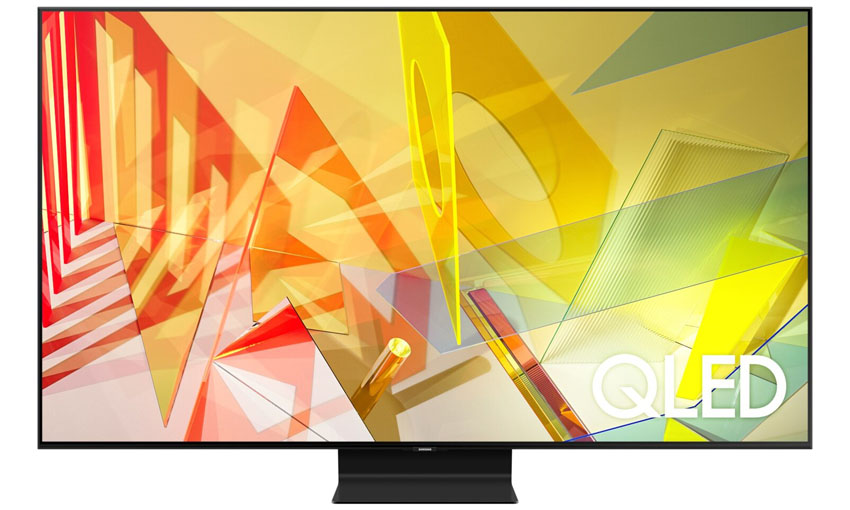
Type : Flat
The Q90T is the first 4K QLED model in the US market and basically is the same as the Q95T with only two differences. It looses the One Connect box which means all the connections are on the main body of the TV instead of a separate box which can also add some thickness overall due to the additional electronics and comes with a slightly lower dimming zones number of 96 compared to the 120 zones of the Q95T.
Everything else is like for like and as such we get the same FALD light system and the same brightness capabilities as the Q95T, the same Quantum Processor 4K along with all it’s AI and upscaling functions, the same simplified Object Sound Tracking audio system along with Tizen and all it’s capabilities and services.
If you live in the US and you are looking for the best 4K model then the Q90T is the one to look for. You can read our in-depth Q90T review in the link for more details.
Specifications
- 4K UHD resolution (3,840 x 2,160)
- QLED display technology
- Full Array Backlight with Local Dimming – Direct Full Array 16X (85″ 20X)
- Quantum HDR 16X
- HDR10+, HDR10 and HLG support
- Quantum Processor 4K
- 4.2.2CH 60W / Object Tracking Sound, Adaptive Sound+, Active Voice Amplifier, Q-Symphony
- 4K AI Upscaling, Ultra Viewing Angle, Adaptive Picture, Multi-View, Real Game Enhancer+, Ambient Mode+
- 4 x HDMI / 2 x USB
- ARC / eARC
- WiFi (802.11ac), Bluetooth v4.2
- Tizen smart platform
- OneRemote
Samsung Q80T
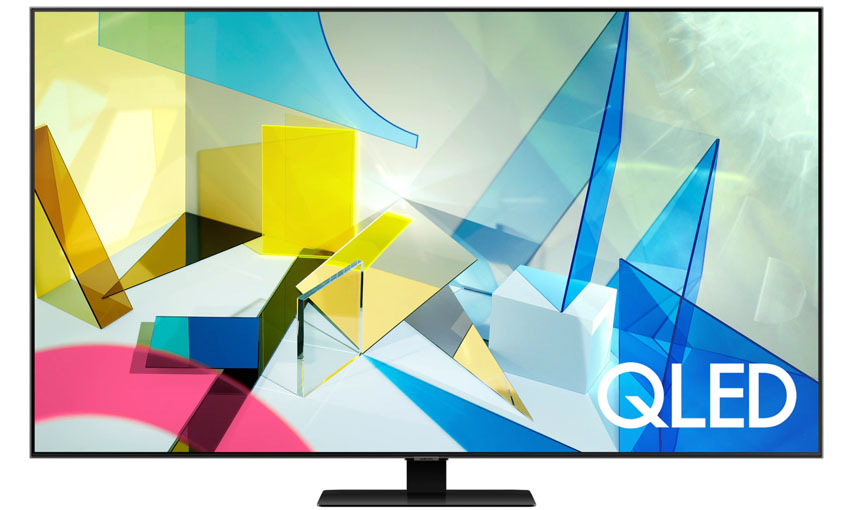
Type : Flat
One step down in the QLED ladder we find the Q80T and we guess this is going to be a TV model that many will look at as this one tries very hard to balance quality and price. The interesting thing here is that the Q80T is the last model that comes with a Full Array with Local Dimming (FALD) light system. Any other TV after this one comes with Edge lit panels so if you are determined to get a TV with a FALD system but want the lowest price possible then the Q80T is the one to look for. Except from the less dimming zones available here the TV is also less brightness capable with the 49″ model getting even lower in it’s brightness rating.
The other downgrade we find is in it’s audio as the Object Tracking Sound system is further downgraded while the 49″ looses it completely. Everything else remain the same with the Quantum Processor 4K still being present along with AI upscaling and Adaptive Picture and obviously Tizen with all it’s smart functions and features.
You can read our full testing of this model in our Q80T review article.
Specifications
- 4K UHD resolution (3,840 x 2,160)
- QLED display technology
- Full Array Backlight with Local Dimming – Direct Full Array 12X (49″ 8X)
- Quantum HDR 12X
- HDR10+, HDR10 and HLG support
- Quantum Processor 4K
- 2.2.2CH 60W / Object Tracking Sound (Not available on 49″), Adaptive Sound+, Active Voice Amplifier, Q-Symphony
- 4K AI Upscaling, Wide Viewing Angle, Adaptive Picture, Multi-View, Real Game Enhancer+, Ambient Mode+
- 4 x HDMI / 2 x USB
- ARC / eARC
- WiFi (802.11ac), Bluetooth v4.2
- Tizen smart platform
- OneRemote
Samsung Q70T
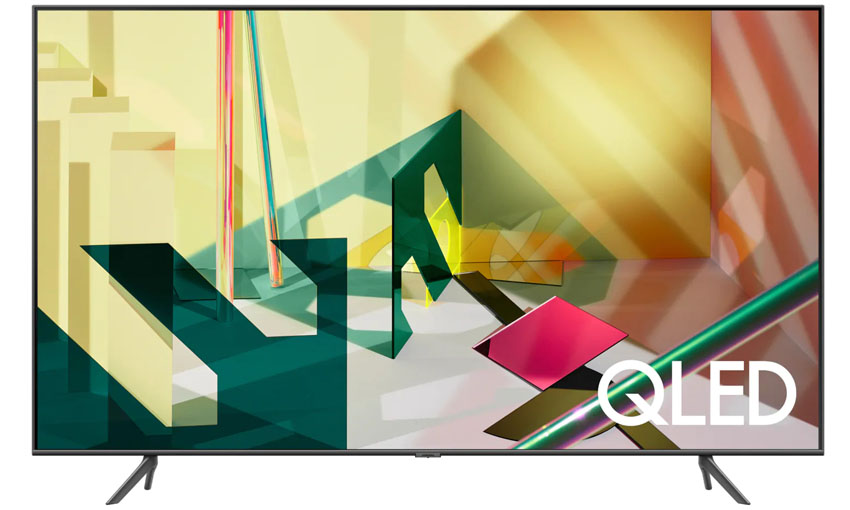
Type : Flat
With the Q70T we are still in the Quantum Dot territory which means you will still get the same color accuracy but visual quality if further reduced as we loose the FALD system and is replaced by what Samsung calls Dual LED backlighting. This is basically an Edge lit system but the main difference this year is that Samsung uses 2 type of color LEDs that they mix in order to produce better results. HDR and brightness capabilities are further reduced compared to the 4K TVs we mentioned above.
The other major downgrade is in it’s sound system as the Q70T looses the Object Tracking Sound setup completely and has to settle to a usual 2 channels audio. Samsung preserved the Quantum Processor 4K here which means we get the same 4K AI upscaling and adaptive features along with Tizen and it’s full list of features and smart services.
Basically this is the best non-FALD model Samsung offers and it surely will find wide acceptance from the mainstream market. You can check our full tests on this model in our dedicated Q70T review.
Specifications
- 4K UHD resolution (3,840 x 2,160)
- QLED display technology
- Dual LED backlighting
- Quantum HDR
- HDR10+, HDR10 and HLG support
- Quantum Processor 4K
- 2CH 20W / Adaptive Sound+, Active Voice Amplifier
- 4K AI Upscaling, Wide Viewing Angle, Adaptive Picture, Multi-View, Real Game Enhancer+, Ambient Mode+
- 4 x HDMI / 2 x USB
- ARC / eARC
- WiFi (802.11ac), Bluetooth v4.2
- Tizen smart platform
- OneRemote
Samsung Q60T
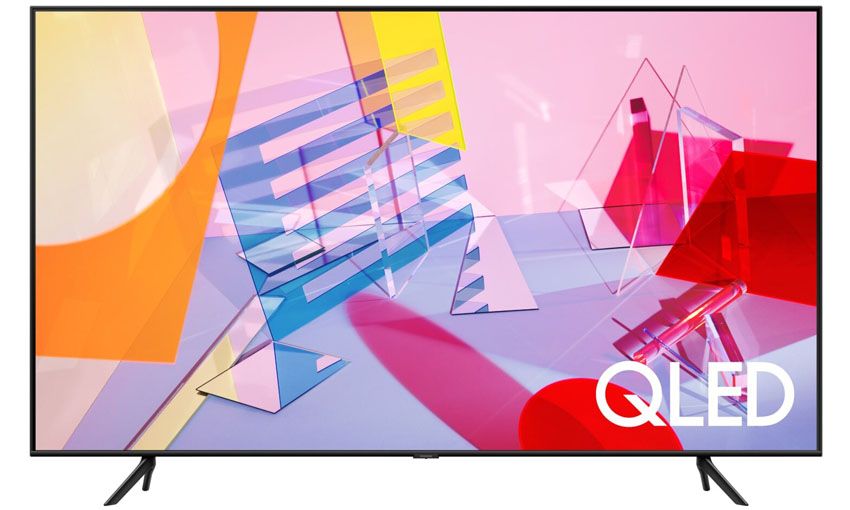
Type : Flat
The Samsung Q60T is the last of the QLED models and this one has many similarities with the Q70T above but has one major difference. The TV uses a less capable processor named Quantum Processor 4K Lite. This means we loose the advanced AI 4K upscaling along with the Adaptive picture, Real Game Enhancer+ and Active Voice Amplifier features. There is also a reduction in the HDMI ports as this one gets only 3 and this is the only QLED that doesn’t feature a HDMI 2.1 port but settles for HDMI 2.0 only.
The rest of the specs seem the same as we also get the same Dual LED light system and same brightness rating as the Q70T along with the same simplified 2 drivers audio system. Software wise Tizen is available along with all the smart features and services available.
The Q60T seems to be in a rather strange place. It may come with the QLED badge but it’s major downgrades will most likely make it behave worse than what any QLED model should. Obviously Samsung wanted a filler between their higher QLED models and their Crystal series so it remains to be seen how good this one will manage to do in retail the coming months.
You can read our in-depth analysis of this model in our Samsung Q60T review.
Specifications
- 4K UHD resolution (3,840 x 2,160)
- QLED display technology
- Dual LED backlighting
- Quantum HDR
- HDR10+, HDR10 and HLG support
- Quantum Processor 4K Lite
- 2CH 20W / Adaptive Sound
- Wide Viewing Angle, Multi-View, Ambient Mode
- 3 x HDMI / 2 x USB
- ARC / eARC
- WiFi, Bluetooth v4.2
- Tizen smart platform
- OneRemote
4K Crystal UHD TVs
Samsung TU8500 (UK/Europe Only)
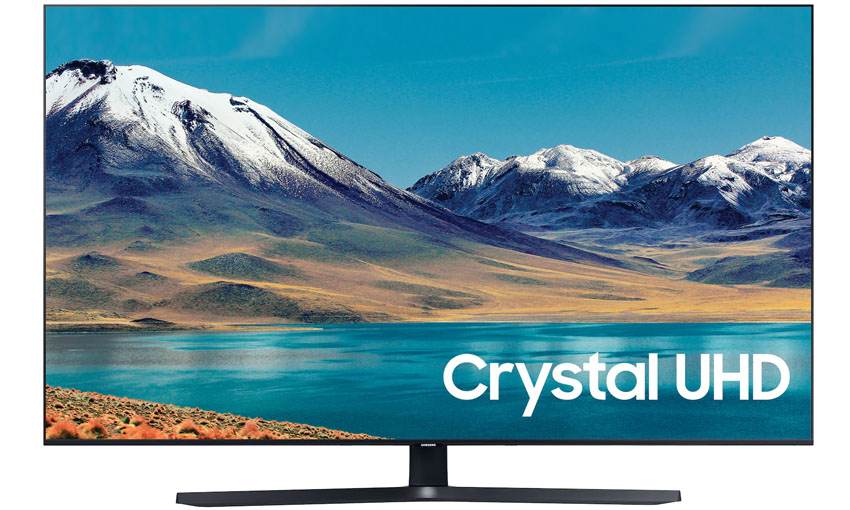
Type : Flat
Samsung has renamed their Premium UHD models and for 2020 we get the Crystal UHD naming which in all honesty feels more catchy even if their capabilities are far less capable than the Quantum Dots. The TU8500 is the highest Crystal TV you can find while it has only been announced for the UK and European markets. The first major change we find in the TU8500 is the use of Dynamic Crystal Display technology instead of Quantum Dots which means less accurate color reproduction. The TV is also less brightness capable according to the given rating.
Another downgrade we find is the use of the Crystal Processor 4K which comes with further reduced capabilities. Everything else is similar to the Q60T with the same audio system and smart functionality including Tizen and all it’s services.
Specifications
- 4K UHD resolution (3,840 x 2,160)
- Dynamic Crystal Display technology
- Dual LED backlighting
- HDR
- HDR10+, HDR10 and HLG support
- Crystal Processor 4K
- 2CH 20W / Adaptive Sound
- Game Enhancer, Multi-View, Ambient Mode
- 3 x HDMI / 2 x USB
- ARC / eARC
- WiFi, Bluetooth v4.2
- Tizen smart platform
- OneRemote
Samsung TU8000
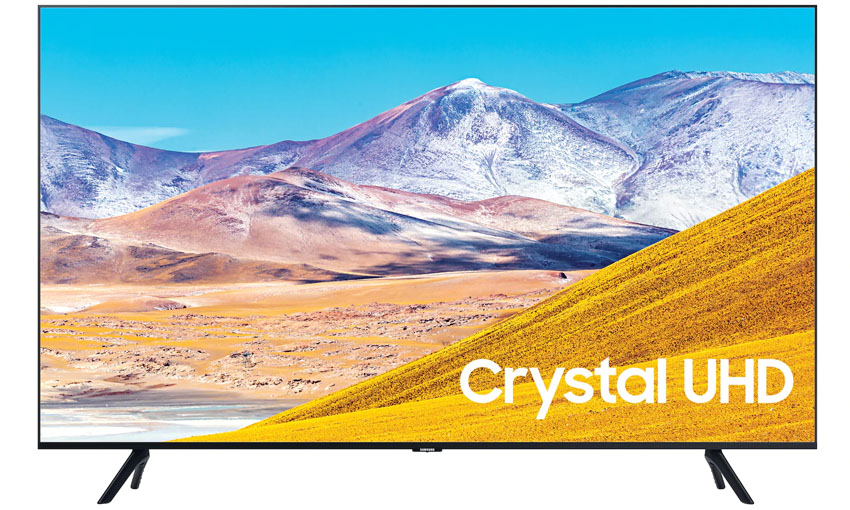
Type : Flat
The TU8000 seems to be the first Crystal TV being sold in the US and the basic differences we find compared to the TU8500 is the less capable panel we get as here it is named just Crystal Display and also no Dual LED backlight system which means less brightness capable. It seems that the TU8000 also looses the Multi-View function that was available in all the other models above. At least this TV still keeps all the smart TV functionality in it’s Tizen platform.
Price will tend to be extremely low in this one and for sure targets those that are looking for a cheap TV but with some added smart functionality. You can read our full testing in our Samsung TU8000 review link.
Specifications
- 4K UHD resolution (3,840 x 2,160)
- Crystal Display technology
- HDR
- HDR10+, HDR10 and HLG support
- Crystal Processor 4K
- 2CH 20W / Adaptive Sound
- Auto Game Mode, Ambient Mode
- 3 x HDMI / 2 x USB
- ARC / eARC
- WiFi (802.11ac), Bluetooth v4.2
- Tizen smart platform
- OneRemote
Samsung TU7100 (UK/Europe Only) / TU7000
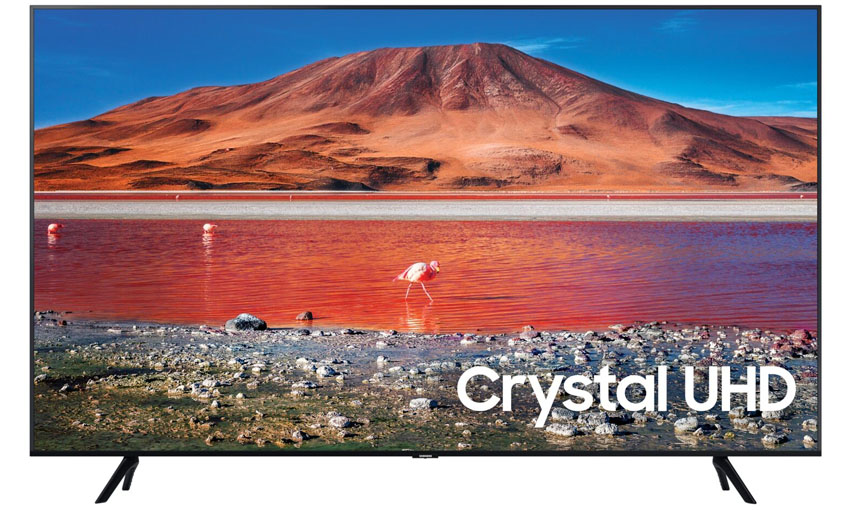
Type : Flat
The TU7100 is the last of the Crystal UHD TVs and this one has many similarities to the TU8000 but also some differences that need mentioning.
Firstly it comes with the same Crystal Display panel technology, it’s the same brightness capable, uses the same Crystal Processor 4K and also uses Tizen.
Now the differences we find is the reduction in 2 HDMI and only 1 USB ports and also looses some of the smart functions that are included in the Tizen platform offering an overall more limited experience. Lastly there is no OneRemote being offered with this model and instead we have to settle with a more casual remote.
There seem to be two variants of this TV with the TU7100 and TU7000 but with the specs being like for like our guess is that their main difference will only be on the color of the design.
You can read our detailed analysis and review of the TU7000 HERE.
Specifications
- 4K UHD resolution (3,840 x 2,160)
- Crystal Display technology
- HDR
- HDR10+, HDR10 and HLG support
- Crystal Processor 4K
- 2CH 20W / Adaptive Sound
- Auto Game Mode
- 2 x HDMI / 1 x USB
- ARC / eARC
- WiFi (802.11ac), Bluetooth v4.2
- Tizen smart platform (Less features)
Lifestyle TVs
The FRAME

Type : Flat
For this year Samsung decided to offer us the 2020 version of the Frame which is basically a 4K QLED model with an artistic twist. In terms of specs it features a Quantum Dot display and a Quantum Processor 4K along with a Dual LED backlight system. From these specs it seems that the Frame, in terms of it’s capabilities, sits somewhere in the Q70T to Q60T range. It also features a more simplified audio system along with Tizen and all it’s functionality and the One Connect Box that allows to hide all wires and connections for a more clean setup.
Obviously design plays a big part of the Frame and as such it gets customizable frames, support for a no-gap wall mount and various stand options while it comes with certain modes and functions in order to support it’s artistic merits.
Specifications
- 4K UHD resolution (3,840 x 2,160)
- QLED display technology
- Dual LED backlighting
- Quantum HDR 4X
- HDR10+, HDR10 and HLG support
- Quantum Processor 4K
- 2.2CH 40W / Adaptive Sound+, Active Voice Amplifier
- AI Upscaling, Wide Viewing Angle, Adaptive Picture, Multi-View, Auto Game Mode, Ambient Mode+
- 4 x HDMI / 2 x USB
- ARC / eARC
- WiFi (802.11ac), Bluetooth v4.2
- Tizen smart platform
- Customizable frame, No-gap wall mount, Stand options, Art store, Auto curation
- Brightness sensor, Motion sensor
- One Connect Box / OneRemote
The Serif

Type : Flat
The Serif is the second model in Samsung’s Lifestyle lineup and again what we get here is a QLED variant that has been fitted in a specially designed frame in order to give it a distinct look. We were always a bit puzzled with the market this one is targeting at and how wide acceptance it can find but offering this model for one more year it seems that Samsung has found an audience for it.
In terms of capabilities the Serif is pretty close to the Frame but seems to use a less capable backlight system along with a lower brightness rating. But it’s main focus seems to be in added functionality and specific looks as it comes with an all around 360 design, uses a brightness sensor, has NFC on TV, Tap View and comes with a detachable floor stand.
Specifications
- 4K UHD resolution (3,840 x 2,160)
- QLED display technology
- Q Contrast backlighting
- Quantum HDR
- HDR10+, HDR10 and HLG support
- Quantum Processor 4K
- 4CH 40W / Adaptive Sound+, Active Voice Amplifier
- 4K AI Upscaling, Wide Viewing Angle, Adaptive Picture, Multi-View, Real Game Enhancer+, Ambient Mode+
- 4 x HDMI / 2 x USB
- ARC / eARC
- WiFi, Bluetooth v4.2
- Tizen smart platform
- All around 360 design, NFC on TV, Tap view, Detachable floor stand
- Brightness sensor
- OneRemote
The rest…
The WALL
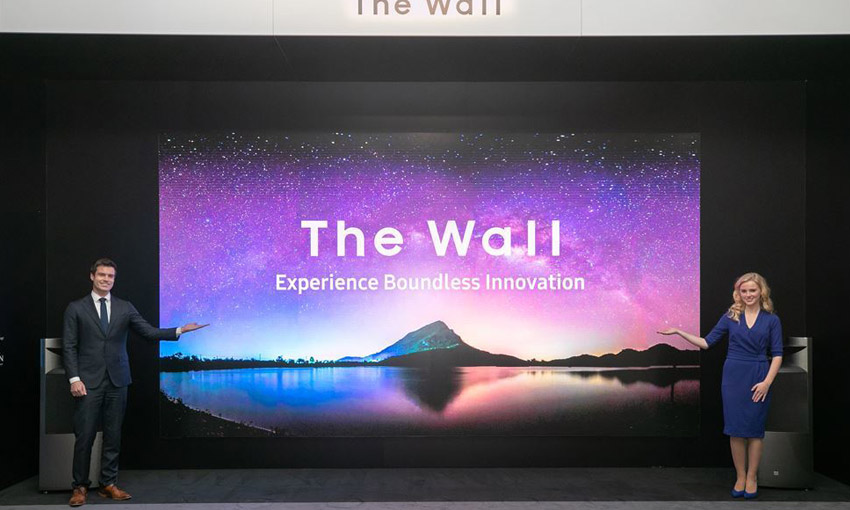
Type : Flat
Samsung may have to sell TVs in order to make money but also has to point to the future and what is to come. And the Wall seems to be such a technology as for one more year it is displayed in all it’s glory. And although the Wall has already been featured in previous events it seems that microLED technology, that is destined to rival OLED, is not yet mature enough to enter mainstream production. And while the Wall is being sold right now, it’s not the kind of TV that you can get on retail while it’s price is outside most people capabilities.
Although Samsung has promised that we will get more of microLED in the near future it still remains to be seen when this exciting technology can be widely used across Samsung’s main lineups. For now we can just look and drool.
Specifications
- 4K UHD resolution (3,840 x 2,160)
- microLED display technology
- LED HDR (Inverse Tone Mapping, Dynamic Peaking, Color Mapping), HDR10/10+, DRE (Dynamic Range Expansion), Low Latency (for Live Mode), Dimming (for Semi-Indoor)
Sero TV
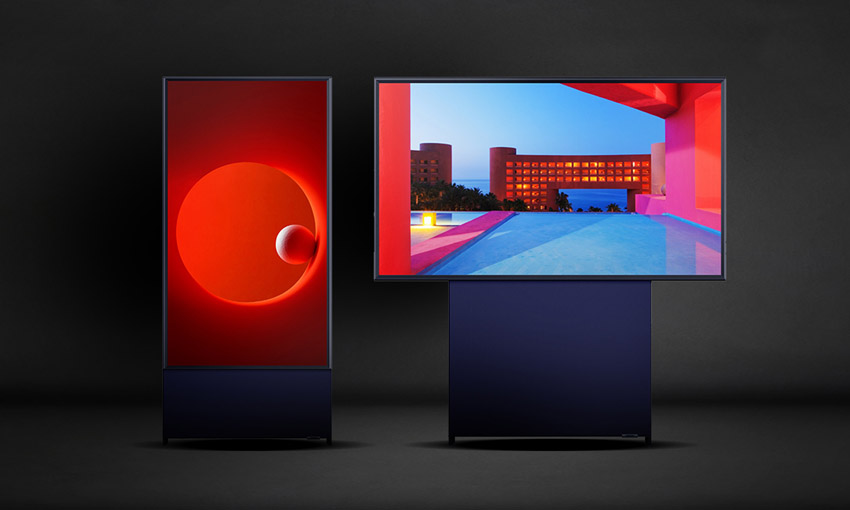
Type : Flat
The Sero TV is an interesting new proposal from Samsung. This is basically a QLED model that can rotate 90 degrees and look like an oversized smartphone screen making it ideal for smartphone integration and interaction. It can also be used as a normal TV so you don’t have to worry about it’s main use. We are very curious to see how this one will do and when Samsung will decide to release it to the markets worldwide so we will keep checking on this new and rather intriguing design from Samsung.
Specifications
- 4K UHD resolution (3,840 x 2,160)
- QLED display technology
- HDR10+, HDR10 and HLG support
- Quantum Processor 4K
- 4.1CH 60W / Adaptive Sound+, Active Voice Amplifier
- AI Upscaling, Adaptive Picture, Auto Game Mode (ALLM), Auto Rotation, Ambient Mode+
- 3 x HDMI / 2 x USB
- ARC / eARC
- WiFi, Bluetooth v4.2
- Tizen smart platform
- OneRemote
8K TVs
4K TVs
LIFESTYLE SERIES
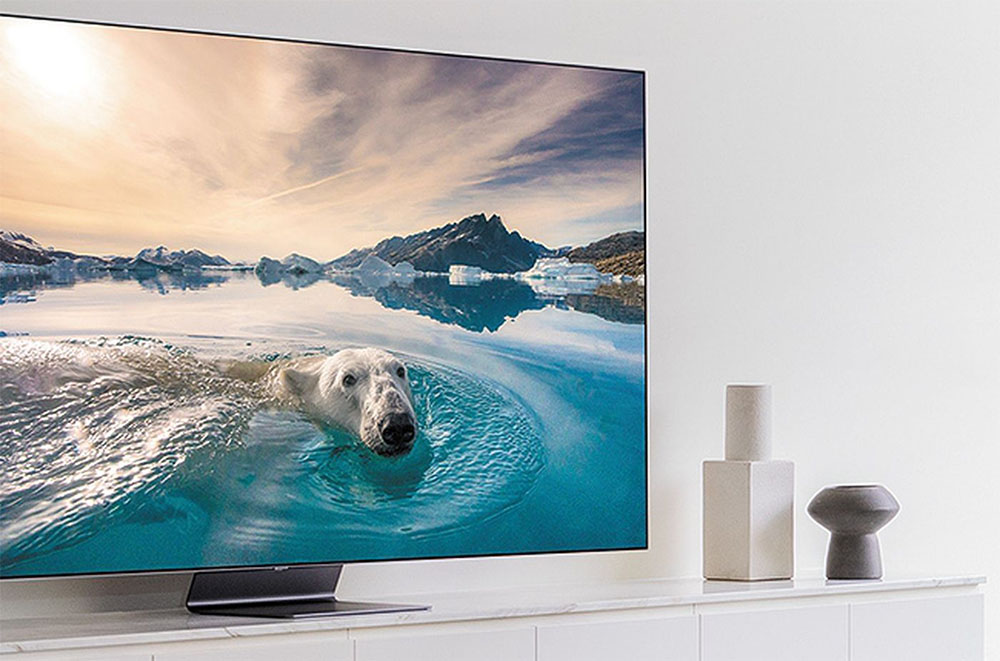
Samsung for sure makes some of the best TVs on the planet and as such I am always excited to see what they have in store for the new year. I agree that with all the different sizes and models it can be confusing to differentiate all the specs and decide which is the best fit. I can’t even imagine having a 292″ TV. That would be like having a movie theater in your home I imagine. Good to know that we likely won’t see any advancements as far as image quality, but more so in the sound department. Image quality is already pretty outstanding, so it would definitely be worth it to upgrade to get a better sound. I have saved your site to reference in the upcoming year, and I will check out your dedicated TV series link as well. Great post!
Throughout the year we will be testing many of these models for sure so keep checking back for more updates soon!
Great post. I don’t have a TV at the moment due to travelling a lot but my last TV was a Samsung. I watched the YouTube link and the advert was impressive but obviously it’s just marketing material. I really like the fact they are concentrating on sound and I’ll tell you why. I visited my folks at Christmas and they have a great TV. Huge screen, fantastic colors and images, the screen pops out at you. It was a great experience however with some movies or shows the sound was off. The background music can overshadow the voices, which is annoying as you can’t hear properly. Next TV I buy, it’s going to be a Samsung.
Audio was always a major problem since the creation of flat TVs. There is simply not enough space in order to fit the necessary hardware that is needed to create more immersive sound. Lately many manufacturers relied on AI processing but even this can do so much to improve things. Samsung’s take with Object Tracking Sound+ seems like an intriguing proposal but remains to be seen how good this will be.
This is certainly a very nice all round guide of the 2020 releases. I was thinking about a Samsung from last year but I thought to wait and see what they had on offer this year. This article has definitely cleared my doubts on which TV brand to get. I think Samsung Q80T won’t be a bad choice.
The Q80T seems like it will be the choice for many people that look for a good quality TV without going overboard with their budget. I think it will be one of the most popular models for 2020.
These reviews are interesting but don’t say much about the durability of the products on offer.
I bought the QE85Q950TSTXXH in 2020.
After 2 years it stopped functioning and was replaced by a new set (under warranty).
Half year later the same problem. This time only the motherboard was replaced.
And aother half year later again the same problem.
Now I wonder if this model as an inherent flaw and I will need to pay every half year for an expensive repair to keep watching TV …
Hello there. Commenting on the durability of a product is practically impossible on a review that we keep only for a few days. There are so many products we test that we cannot possibly check them every few months to see how they hold up. Some products are obviously more susceptive to break down and yours may be one of them.